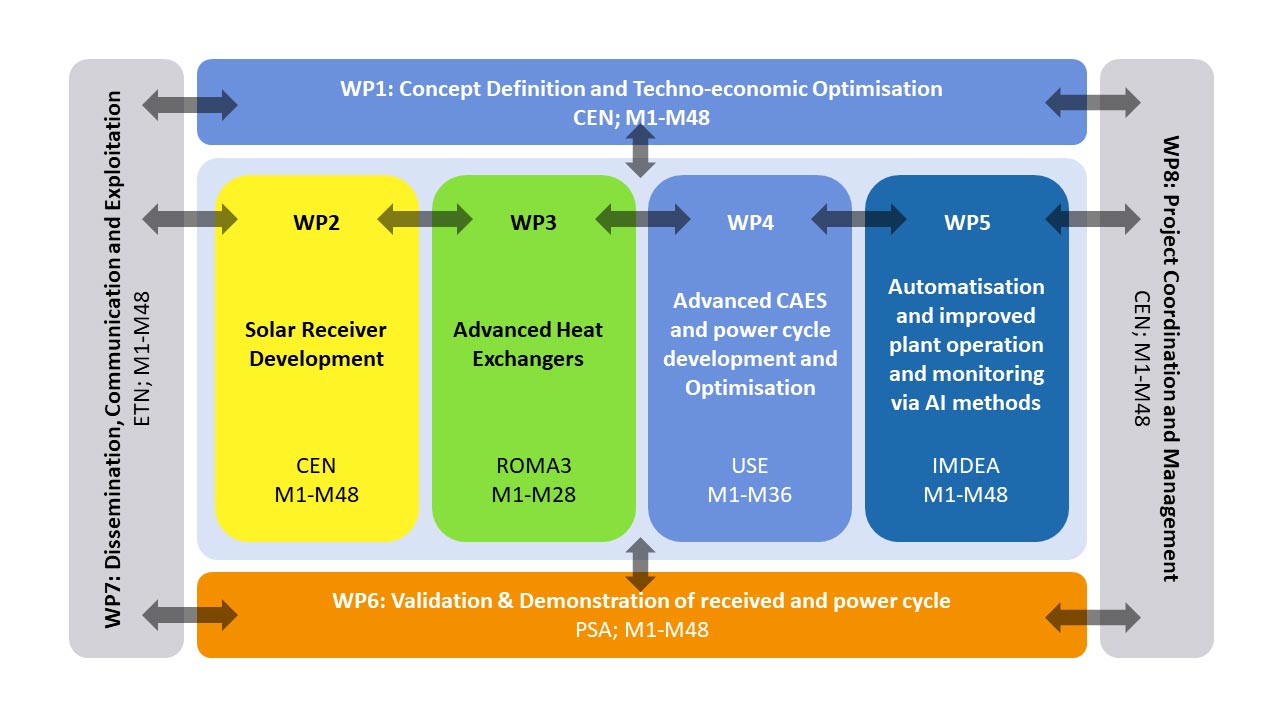ASTERIx-CAESar project is planned to last 48 months – from October 2023 to September 2027.
It is divided into 8 Work Packages (WP) that are mutually related and thus encourage cooperation amongst the partners.

WP1 main objectives are:
- To define requirements, specifications and possible barriers of the ASTERIx-CAESar overall concept;
- To define specifications of the experimental prototypes and validation activities to address TRL-6/7;
- Evaluation of different compressed air storage solutions (aboveground and underground) to identify the most efficient and cost-effective options;
- Techno-economic optimization of ASTERIx-CAESar concept taking into account different use-cases (also considering integration with desalination and process heat);
- To assess the environmental sustainability through Life Cycle Analysis and recyclability potential;
- To assess the socio-economic sustainability and social impact;
- Define and monitor KPIs for project development, validation, and perform the risk analysis and mitigation.
WP2 main objectives are:
- Optimizing the ASTERIx-CAESar solar receiver based on the developments done in the finished H2020 project CAPTure;
- Optimize the ceramic foam solar absorber to maximize lifetime for high-flux-density commercial operation;
- Optimize the ceramic receiver structure (stackable free-floating modules);
- Optimize the ceramic receiver airflow guiding elements (orifices, dampers);
- Optimize the high-performance thermal insulation and radiation shields;
- Perform an iterative optimization procedure combining numerical as well as experimental evaluation at module (10-20 kW thermal) as well as validation/demonstration scale (480 kW thermal);
- Design and manufacture receiver prototypes in order to be tested experimentally at module and validation scale;
- Optimize material utilization considering cost, manufacturing as well as environmental impact.
WP3 main objectives are:
- Identify the optimum heat exchanger configuration for low and high temperature exchangers (complete design study on paper);
- Perform a detailed parametric design study applying 1-D Modelica models;
- Feed/fine-tune the Modelica code with heat transfer and pressure drop parameters coming from CFD modelling and experiments;
- Benchmark the classic indirect recuperative heat exchanger concept against regenerative heat exchangers;
- Optimum material selection considering cost, performance as well as environmental impact and recyclability;
- Identify process control challenges and provide suitable methods.
WP4 main objectives are:
- Provide optimized layouts of compressor and expander trains for small-scale (≈1 MWe) as well as for large-scale implementation (up to about 150 MWe);
- Propose design modifications based on available turbomachinery;
- Establish reliable turbomachinery performance maps and cost data for the techno-economic optimization study in WP1;
- Address turbo-machinery specific control issues;
- Design and optimization of the bottoming cycle architecture (steam or organic working fluid Rankine cycle);
- Overall parameter optimization and definition of the novel energy storage and combined cycle power generation unit;
- Establish overall performance and cost data for the techno-economic optimization study in WP1.
WP5 main objectives are:
- Develop a fast, dynamic, accurate, adaptive, and predictive AI-based heliostat control system for CSP central receiver plants to ensure a well-defined and stable solar flux distribution;
- Develop a reliable fibre-optic based sensor measurement system for the concentrated solar flux and temperature distributions on central receivers;
- Demonstrate the AI-based heliostat control system during at least 6 months of operation at IMDEA and PSA CRS experimental tower in relevant environment.
WP6 main objectives are:
- Experimentally evaluate the thermal behaviour of the ASTERIx-CAESar solar absorbers at module-scale (10-20 kWth) and validation/validation scale (480 kWth);
- Adapt the existing CAPTure prototype to allow the demonstration of the key components of the ASTERIx-CAESar concept in the relevant environment;
- Operate a demonstration-scale (TRL6/7) solar powered CAES plant in the in relevant environment, in combination with a small-scale RO desalination unit coupled by a gas-liquid pressure exchanger.
WP7 main objectives are:
- Develop and implement a targeted dissemination and communication strategy for maximum project visibility and impact in relevant areas at local, national and international levels;
- Design tools and materials for dissemination and communication that target a variety of stakeholders, incl. the scientific community, industry, policy makers, and the wider public;
- Coordinate the exploitation of results, manage project innovation and IP and develop a preliminary Exploitation Roadmap and follow-up strategies to secure the future uptake of project results;
- Coordinate knowledge exchange and dialogues with key stakeholders to maximize the impact of ASTERIx-CAESar, while minimizing risks that could hamper the uptake of project results;
- The continuous update of the project’s context to anticipate the changes in the market´s trends by efficient innovation management;
- Consolidating synergies with other EU-funded projects and EC cluster and initiatives.
WP8 main objectives are:
- Establish a reliable interface to the EC services;
- ASTERIx-CAESar project management, including:
- Coordination of the project WPs (through WP leaders) according to the work plan, ensuring high quality project outcomes;
- Efficient and high-quality communication between all the partners;
- Coordination of financial reporting;
- Distribution of the financial support received from the Commission to the partners;
- Considering relevant gender issues.
